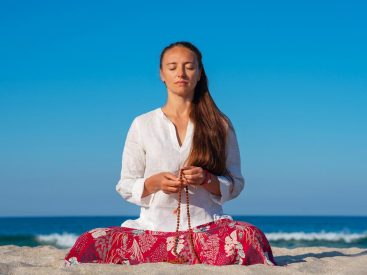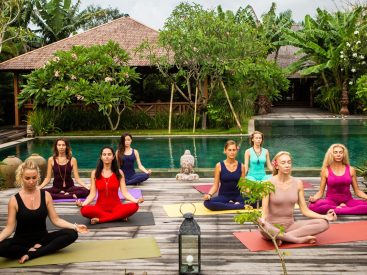MEditation, today this word is heard … Many of us have heard about it, saw that there are different classes and methods of teaching meditation, someone attends them, and some of us are already meditating or think that we are meditating.
So what is meditation? Where to start? What is the correct way to carry out this practice? Fortunately, we live in a time when a stream, an avalanche of information is pouring on us. But nobody canceled the difficulty of the choice. And we must very sensitively filter, sift through articles, books, videos, classes in order to feel, understand and carry through our perception the pearl of meditation: its taste, aftertaste, healing, opening, relaxation, transformation – all the fruits that meditation can give everyone of us.
Since the mid-20th century, scientific researchers have become interested in meditation in terms of relaxation, cleansing, and rebooting the mind through physical and mental exercise. Scientists have been able to prove a direct link between meditation practices and the improvement of the health of meditators. Research has confirmed the benefits of regular exercise. In addition to general relaxation, pressure is normalized, mental activity improves, the work of the entire human biosystem is harmonized, and a general surge of strength is observed.
Meditation is known to us as part of the spiritual practice of Vedic culture. It is said that the first texts were described even before our era. In China, where Buddha was worshiped, later the techniques of meditation changed, and they also led to harmony of the spirit. We have heard a lot about monks who have comprehended Zen (enlightenment), they were able to reveal the ancient recipes of spiritual harmony to their adepts. Thanks to this, meditation, as a way of self-knowledge, healing, harmonization, spiritual growth, has become available and popular.
Probably, there is no meditation for beginners, as it relates to dhyana – the seventh stage of yoga. This means that we must not only observe self-control in relation to ourselves, our feelings, emotions, living beings around us. We must know the unity in yoga: soul, mind and body. And this is OBSERVATION. Observing thoughts, words, emotions, actions, deeds.
We are able to observe lying, sitting, in motion, only by adjusting our mind, that is, by changing our mood. The easiest, most effective and affordable way to influence your own mood is music. The selection of music for meditation practices is one of the components of achieving a result. The melody, when it is “yours”, will surely touch the strings of the soul. Usually a calm, blissful, soft, peaceful composition without words has a positive effect. Its effect will begin to impose breathing on the rhythm and relax tense muscles, you will want to gently close your eyes and concentrate on the sensations. The positive vibrations of meditative melodies will begin to resonate and interact with the body and mind.
It is very wise to use the sounds of nature, especially the “breath of the ocean”, which create a favorable atmosphere for relaxation. The main thing is that the sound does not evoke sadness, despondency, irritation, fear, but is associated with pleasant memories or associations.
There are many meditation techniques for beginners in the field. Perhaps the easiest, most enjoyable and effective way is to pay attention to your breathing cycle. Without inventing anything, you must constantly return your attention to inhalation – exhalation, to be aware of how air enters the nostrils and fills the lungs. We present in detail the process of life: how the whole body is saturated, oxygen feeds every cell of the body.
Also, sitting in a comfortable position with an even spine, you can observe incoming thoughts without developing an internal dialogue, accompanying them like clouds floating by.
To rid oneself of stressful manifestations, tension, a beginner practitioner uses tactile relaxation. Rosary beads are commonly used. Getting acquainted with the subject of relaxation, we hold it in our hands and mentally track its shape, temperature, surface. Then we sort out the beads of the rosary in our fingers or another object from hand to hand, direct all our attention to this process, we do it slowly, at the same pace. And we say or sing to ourselves a mantra, a prayer.
One of the exercises of meditation is to concentrate on some object or phenomenon. Contemplation of fire in a bonfire, candle flame, rolling waves, movement of clouds, the appearance of a rainbow after rain, sunset or sunrise on the horizon. It is necessary to take advantage of the divine beauty and enjoy it consciously. Meditative contemplation exercises restore peace of mind, peace and saturate with vital energy.
Of course, everyone chooses the place, the way of meditation, but there are several basic rules of meditation that should be followed.
- Correct posture is the basis for meditation. It is necessary to keep the spine and neck straight and straight while sitting on the floor or on a chair. Try not to slouch! Hands are placed on the knees, palms up, or mudra is used. We direct the tongue to the upper palate. We close our eyes or slightly cover them. This is the basis for calming the mind.
- In order that, having calmed our mind, we do not fall asleep quickly and safely, we must hold the object of meditation. The most accessible is our breath.
- The meditation time should be gradually increased, the experienced practitioner can quickly tune the mind and enter the process, and it will take longer for beginners or emotional people. Therefore, you need to start from 10 – 15 minutes to 45 – 60 minutes – these are general recommendations. Gradually, we will learn to meditate without a dedicated time. This will be a careful observation of objective reality, of any process or person entering our life.
- You can meditate anywhere and anytime. It is not at all necessary to sit alone and with your eyes closed. It can be a walk, a trip, doing work, practice.
- During meditation, the mind becomes aware. It may seem that this further affects emotionality, anxiety, irritability. The main thing is not to stop and move on, exploring the traps of the mind, that is, yourself. It will take time to resolve important issues, thoughts and concerns. Therefore, be patient!
And yet, meditation is not limited to specific methods, techniques and exercises, techniques and techniques, nor can it be said that certain states are achieved by it. It is growth, expansion and self-realization.
Alas, to most people today, this seems to be “notions”, they do not even know about their own spiritual potential. Unfortunately, people have completely disaccustomed to trust themselves and listen to their inner voice. Immersion in the vanity of worldly affairs does not allow you to always remember your Beginning. All these are loud words …
Therefore, it is easier to start with deep muscle relaxation, release of body tension. Relaxation of muscle tone, bone structure is achievable in the process of certain work. But for this, time should be allocated. And already the next stage of practice will be stabilization, internal experiences, states, calming and stabilization of mental vortices. Thus, you can come to meditation through relaxation, directing your attention not “outside”, but inside yourself, achieving a state of calmness, conservation and increase of energy.
Krishnamurti said, “Meditation cannot be learned. It is growth: the growth of your entire life process, out of your entire life process. You have to grow towards meditation. ”
Therefore, the main goal of the practice is to become yourself in your Nature, to find yourself, to accept and love. This will be followed by the acceptance of everything that surrounds us: close people, colleagues, boss, passer-by, situations, very different every day … We will learn to carefully observe the realities of life, change our mood, manifesting ourselves first of all on what is happening around. Drawing wisdom and an answer from the depths, how to act in a given situation.


